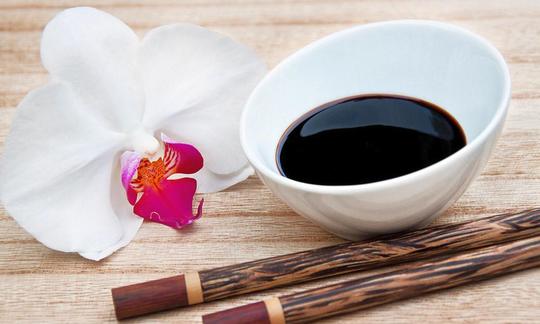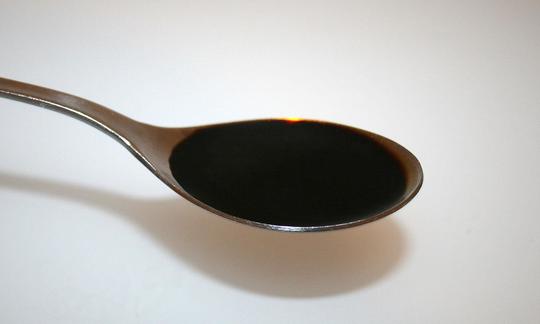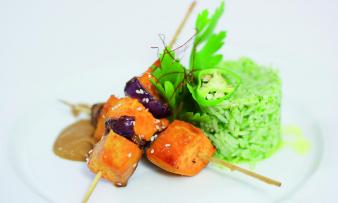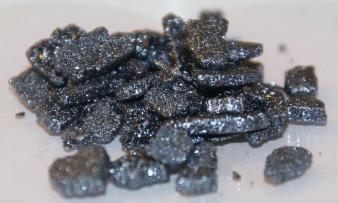Table of contents
Sweet soy sauce , also called Ketjap Manis (Kecap Manis), is a dark, thick seasoning sauce from Indonesia sweetened with palm sugar. It is not raw, but is available in organic quality.
Use in the kitchen
What is sweet soy sauce? Ketjap Manis or Kecap Manis is a thick, dark, sweet soy sauce from Indonesia. What is soy sauce (sweet) made of? The main ingredients for making Ketjap Manis are black soybeans , molds (often of the genus Aspergillus ), salt , water , possibly spices (such as star anise ) and up to 50% palm sugar ( coconut blossom sugar ). In contrast to salty soy sauce, the taste of sweet soy sauce is intensely sweet. Of course, it also tastes salty and serves the famous umami taste. 1,2,3
The spicy-sweet sauce is a component of many typical Indonesian dishes, such as Nasi Goreng, Mie Goreng, Kwetiau Goreng and Ketoprak. It is also ideal for marinating tofu , tempeh or various vegetables. The grilled dish Satay is particularly popular and can also be prepared vegan, as in the following recipe: Sweet potato satay with spicy peanut sauce . Ketjap Manis also tastes good as a vegan dipping sauce for grilled tofu, spring rolls, raw vegetable sticks or unusual sushi creations. Sweet soy sauce is also used to flavour, refine and season soups, sauces, salad dressings, stews and vegetable dishes and gives all kinds of dishes a sweet umami note.
Is sweet soy sauce raw? Soy sauce, also known as sweet soy sauce, is not a raw food product. During the manufacturing process, the soybeans are heated, as they are only digestible after this. When raw, they contain the glycoprotein phasin, which is toxic to humans. In addition, the soy sauce must be boiled down with sugar to make Ketjap Manis.
Is sweet soy sauce gluten-free? Unlike Shoyu (Japanese soy sauce), Ketjap Manis is traditionally made without wheat and is therefore gluten-free. However, sweet soy sauces containing wheat are increasingly found. Pay attention to the list of ingredients and the allergy information provided.
Is sweet soy sauce vegan? Sweet soy sauce is generally vegan. Some manufacturers add fish sauce or fish extract, but this should be clear on the product.
Vegan recipe for Nasi Goreng with Ketjap Manis
Ingredients (for 2 people): 200 g basmati rice , 250 g oyster mushrooms , 1 broccoli , 1 red onion , 2 cloves of garlic , 1 red chili , 100 g peas (frozen) , 2 tbsp rapeseed oil , 3 tbsp sweet soy sauce (Ketjap Manis; prefer organic quality), 2 tbsp reduced-salt soy sauce (Genen Shoyu) , 2 stalks of coriander .
Preparation: Prepare basmati rice according to the instructions on the packet. Clean the oyster mushrooms and cut into thin strips. Separate the broccoli florets and pluck or cut into bite-sized pieces. Peel the red onion and garlic cloves and dice finely. Rinse the chili and cut into rings. Heat the rapeseed oil in a large frying pan or wok and briefly fry the mushrooms. Add the onion, garlic and chili and fry. Add the broccoli and fry for a few minutes. Add the frozen peas and mix everything well. Season with Ketjap Manis and Genen Shoyu. Fold in the cooked rice and fry until hot. Garnish the vegan nasi goreng with washed, shaken-dry coriander leaves and serve.
Vegan recipes with sweet soy sauce can be found under the note: " Recipes that have the most of this ingredient ".
| Not only vegans or vegetarians should read this: Vegans often eat unhealthily. Avoidable nutritional mistakes . |
Purchasing - Storage
Sweet soy sauce is available in well-stocked branches of larger supermarket chains, such as Coop , Spar , Rewe and Billa . It is often unclear whether it is Ketjap Manis (soy sauce cooked down with palm sugar ) or soy sauce sweetened with cane sugar or other sweeteners (e.g. rice syrup ). Other supermarkets (e.g. Migros , Denner , Volg , Aldi , Lidl , Edeka , Hofer ) and organic supermarkets (e.g. Denn's Biomarkt , Alnatura ) do not have sweet soy sauce in their range or only occasionally. You will most likely find it in Asian grocery stores. Otherwise, Ketjap Manis can be bought in some online shops - including organic quality.
Alternatively, you can make sweet soy sauce from regular soy sauce by adding brown sugar and a little molasses, but you won't get the syrupy consistency.
The availability of sweet soy sauce varies depending on the size of the store, catchment area, etc. You can find our recorded food prices for the DA-CH countries above under the ingredient image - and by clicking you can see their development at different suppliers.
Storage tips:
Unopened soy sauces should be stored in a cool, dry place away from light. Once opened, the bottles are best stored in the refrigerator and used within a few months.
Ingredients - Nutritional values - Calories
The energy content of sweet soy sauce (Ketjap Manis) is 197 kcal/100g. Proteins are contained at 2.8 g/100g. In addition to the high sugar content of 42 g/100g, sweet soy sauce also contains a lot of salt. The salt content of this example sauce is 10.8 g/100g (448.7% of the daily requirement). In comparison: a so-called "salty" soy sauce (Shoyu) contains around 14 g of salt per 100g. 4.5
Ketjap Manis is also rich in iodine with 75 µg/100g (50% of the daily requirement). Similar amounts can be found in sea salt (100 µg/100g) and dried shiitake mushrooms (53 µg/100g). Seaweed has an even higher iodine content, such as dried kombu seaweed (295,400 µg/100g). 4,5 Make sure you only eat small amounts of foods that contain a lot of iodine - read more about the harmful effects of iodine in the seaweed articles, e.g. Laminaria seaweed .
100 g of sweet soy sauce contains 14 µg of vitamin K (19% of the daily requirement). The content is comparable to that of vegan vegetable stock (14 µg/100g) and pomegranate syrup (14 µg/100g). Spinach is particularly rich in vitamin K with 483 µg/100g. 4.5
323 mg of potassium are contained in 100 g of Ketjap Manis (16% of the daily requirement). Coconut cream (325 mg/100g) and malt syrup (320 mg/100g) have similar potassium contents. Dried herbs contain many times more potassium, such as dried coriander leaves with 4,466 mg/100g (= 44.66 mg/1g). 4,5 However, it is important to note that spices and dried herbs are usually only used in small amounts.
The complete ingredients of sweet soy sauce, the coverage of the daily requirement and comparison values with other ingredients can be found in our nutrient tables. In the article Nutrients explained you will get a detailed insight into the topic.
Effects on health
How healthy is soy sauce? According to some studies, soy sauce (not specifically sweet soy sauce) has antioxidant, antihyperuricemic (hyperuricemia = high uric acid levels in the blood), antimicrobial, anticarcinogenic, anti-cataract and anti-blood clot effects. 6 However, these effects have not yet been fully researched. It is also unclear whether the results are transferable to humans.
In 2019, researchers investigated the physiological effects of soy sauce on nematodes ( Caenorhabditis elegans ). Among other things, it was observed that the nematodes responded with increased tolerance to oxidative stress and showed increased resistance to pathogens after being fed soy sauce. 7
It is possible that herbs and spices used to make Ketjap Manis may enhance or weaken certain effects.
Secondary plant substances
Many of the potential health effects of soy sauce can be attributed to the secondary plant substances it contains (some of which come from the soybean and some of which are created through fermentation). Our article on secondary plant substances provides an overview of the classification of substance groups, their occurrence in foods and possible effects on humans. Soy sauce contains the following secondary plant substances, among others: 6,8
- Polyphenols : phenolic acids, isoflavones, furanones, pyranones
- Alkaloids : β-Carbolines
- Nitrogen-containing compounds : Melanoidins
However, it should be noted that the composition of the secondary plant substances in soy sauce can vary depending on the brand, time of harvest and growing conditions of the soybeans. Therefore, quantities are only of limited use and should only be understood roughly.
Polyphenols, melanoidins, free amino acids and low molecular weight peptides are associated with the antioxidant effect of soy sauce, which helps reduce oxidative damage by eliminating free radicals and reactive oxygen species. 8
Dangers - Intolerances - Side effects
Soy and wheat are among the most allergenic foods. However, soy sauce appears to be hypoallergenic. This is because microbial proteolytic enzymes break down the soybean allergens (and possibly wheat allergens) during fermentation. 9 Nevertheless, it is known that some people suffer from skin irritation, dermatitis or cellulite after consuming soy sauce. The triggers for these reactions may be histamine or other substances that are produced during fermentation. 10
Is soy sauce unhealthy? Soy sauce, also known as sweet soy sauce, is a food that is high in salt. The World Health Organization (WHO) recommends limiting an adult's daily salt intake to 5 g (that's about 2 g of sodium). To illustrate, 1 tablespoon (about 10 g) of sweet soy sauce contains about 1.1 g of salt. High salt consumption can lead to an increased risk of high blood pressure, cardiovascular disease, kidney failure, stomach cancer, osteoporosis, obesity and Meniere's disease. 11,12,13,14 Read more about the harmful health effects of excessive salt consumption and ways to reduce your salt intake in the articles on salt and sea salt .
Sweet soy sauce also contains a considerable amount of sugar (up to 50%). In the case of Ketjap Manis, palm sugar (coconut blossom sugar) is traditionally added to the soy sauce. Make sure to consume it in moderation. You can find out more about the effects of coconut blossom sugar or sugar in general on the body in the related articles.
Ecological footprint - animal welfare
The CO 2 footprint is primarily used to assess the climate friendliness of a food. This depends on various aspects, such as cultivation method (conventional/organic), seasonality, country of origin, processing, transport and, if applicable, packaging. According to The Big Climate Database, the CO 2 footprint of soy sauce is 1.64 kg CO 2 eq/kg, according to Carboncloud 1.23 kg CO 2 eq/kg (soy sauce in glass bottles from Great Britain). 15, 16 In comparison: beef, which can also produce the umami taste, causes an average of 13.6 kg CO 2 eq/kg. 17 Other seasoning sauces, such as chili sauce or barbecue sauce, have a CO 2 footprint of 1.94 CO 2 eq/kg and 2.09 kg CO 2 eq/kg, respectively. 18
The water footprint of soy sauce is approximately 606-1986.35 l of water per 1 kg of product. The higher value is based on a calculation that includes the cultivation of soybeans and their processing into soy sauce (without wheat) in Indonesia (Grobogan). The lower value is an average of three soy sauce products (with wheat). 19.20
In conventional agriculture, synthetic pesticides are often used to combat unwanted plants and insects. These have been proven to have a negative impact on the environment and affect important pollinators, birds and mammals, among others. Accordingly, when buying soy sauce, you should buy organic products in order to protect biodiversity and your own health, among other things. The use of such pesticides is prohibited in organic farming. You can read more about the use of pesticides and biodiversity loss in the articles on wheat and soybeans .
For detailed explanations of various sustainability indicators (such as ecological footprint, CO2 footprint, water footprint), see our article: What does the ecological footprint mean?
Worldwide occurrence - cultivation
Soy sauce is a traditional East Asian seasoning that originally came from China (around 2500 years ago). At that time, it was used primarily to preserve food (due to its salt content) and to improve the taste of the modest, vegetarian, Buddhist diet. Today, soy sauce is used much more as a seasoning than as a preservative. In addition, the spicy sauce is now popular worldwide. 1, 21
The sweet soy sauce Kejap Manis was probably developed in the mid-19th century. It is believed that Chinese immigrants who settled in Java noticed that the local population had a taste for sweet things. So they added palm sugar ('Gula Jawa') to the soy sauce. 22
Kejap Manis is very popular in Indonesia and accounts for an estimated 90% of the country's total soy sauce production. 3
Industrial production
The soy sauce for Kejap Manis is made in a similar way to traditional Chinese soy sauce and Japanese shoyu , namely through natural fermentation processes. Soaked, cooked black soybeans are used, which are inoculated with harmless molds of the genus Aspergillus or Rhizopus . The fungi multiply on the soybeans over the next few days. Fermentation in brine follows, which can take a few months. The resulting mash is called moromi. After fermentation is complete, it is boiled, filtered and pressed to extract the flavorful liquid (soy sauce). 2,3
In the last phase, 40-50% palm sugar ( coconut blossom sugar ) is added to the soy sauce and the mixture is boiled for one to several hours to obtain sweet soy sauce. Various spices and herbs are often added, such as star anise , coriander , fennel seeds , garlic , lemongrass , laos and salam leaves. Some manufacturers also add fish sauce or extract or broth as well as wheat flour or cassava flour as a thickener. After filtering again, the thick, sweet soy sauce Kejap Manis is bottled. 2,3
Many volatiles in Kejap Manis are due to the Maillard reaction (non-enzymatic browning reaction during cooking/frying; releases flavors), such as furans, pyrazines and pyrroles. These compounds mainly come from coconut sugar and are also formed during the cooking process. Other components are caused by spices and moromi (e.g. anethole, esters, aldehydes, carboxylic acids, alcohols and benzene derivatives). A number of acids from coconut sugar, e.g. malic acid and citric acid, may play a role in forming the flavor of Kejap Manis. 2
Further information
In Indonesia, the word 'Kecap' ('Ketjap'), used alone, means soy sauce. There are several variants of it: 3
- Kecap Manis (thick, sweet soy sauce)
- Kecap Asin (thin, salty soy sauce)
- Kecap Sedang (in taste and consistency lies in the middle of Kecap Manis and Kecap Asin)
- Kecap Hitam (very dark soy sauce)
- Kecap Ikan (fish sauce)
A similar type of soy sauce to Kejap Manis, which comes from Indonesia, is also produced in Malaysia and Singapore under the name 'Kicap', but it is not cooked for long and no spices are added, just a little caramel. 2
You can also find detailed articles about the following soy sauces: Shoyu , Genen Shoyu and Tamari .
Alternative names
Sweet soy sauce (sweet soy sauce) can also be found under the names Kejap Manis (Kecap Manis, Ketchup Manis), Indonesian soy sauce or sweet soy sauce.
In English, sweet soy sauce is called sweet soy sauce, sweet soya sauce or kecap manis.











Comments